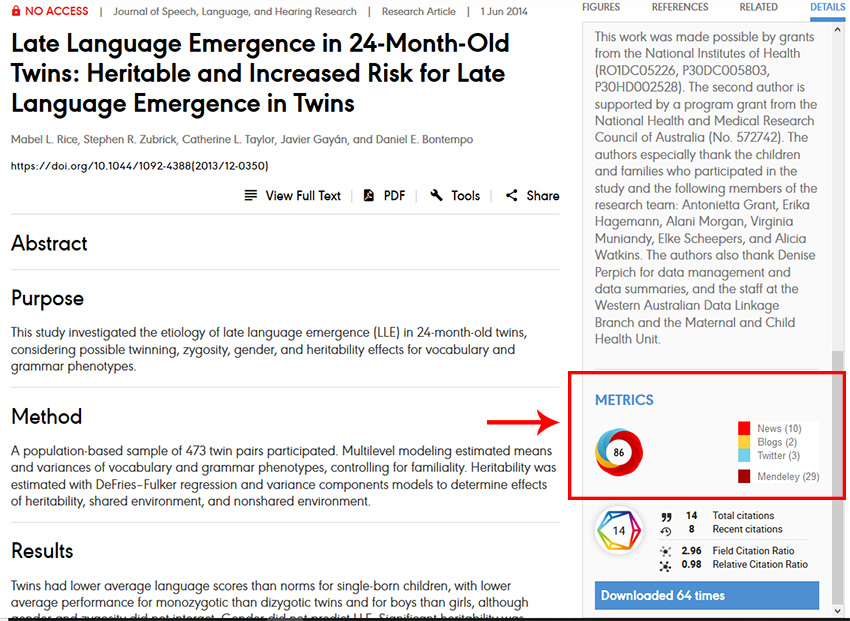Overview
Researchers, funders and institutions are increasingly concerned about the impact of their work and returns on their investments.
The traditional methods of counting citations and downloads to measure impact misses much, not least the reception to published research amongst wider society. As a result, there has been a desire in the scholarly community to gain a better understanding of the reach and attention a paper receives beyond the academic sphere.
‘Altmetrics’, or alternative metrics, have evolved help answer those questions by tracking and collating mentions and shares of academic research papers and other outputs (such as datasets) across traditional and social media outlets, blogs, public policy documents, post-publication peer-review forums and online reference managers.
Altmetric on the ASHA Journals
Altmetrics data is now available on articles published in ASHA journals, including the American Journal of Audiology; the American Journal of Speech-Language Pathology; the Journal of Speech, Language, and Hearing Research; Language, Speech, and Hearing Services in Schools; and Perspectives
Altmetric LLP, who provide the data, collect article level metrics and the online conversations around research papers by tracking a selection of online indicators (both scholarly and non-scholarly) to give a measurement of digital impact and reach. ‘Mentions’ that contain links to any version of the same paper are picked up, and collated. The result is the Altmetric score.
The Altmetric data available on the journal articles allows you to:
- See the attention that each article is receiving from non-traditional sources, including;
- mainstream and social media
- published policy documents
- online reference managers
- post-publication peer-review forums
- Explore the conversations surrounding the content
- Identify recent papers your peers think are interesting
The Altmetric Score
The score is a quantitative measure of the attention that a scholarly article has received. It is derived from three main factors
- Volume:The score for an article rises as more people mention it.
- Sources:Each category of mention contributes base amount to the final score.
- Authors: How often authors of each mention talks about scholarly articles influences the contribution of mention.
On the ASHAWire journal platform, the overall score for each article is displayed in the sidebar on the right side of the article page.
Altmetric on ASHAWire
Altmetrics data is now available on JSLHR, LSHSS, AJSLP, AJA, and Perspectives articles.
On the ASHAWire platform, the overall score for each article (where data is available) is displayed in an Altmetric badge, located in the right sidebar of the article page.

You can click on the Altmetric badge to be taken to the article details page, which will show you each mention of the paper. The ring-shaped donut visualization will differ in color depending on what sources the article has mentions from – blue for twitter, yellow for blogs, red for mainstream media sources – and so on.

What Can I Do With This Data?
Altmetrics can be useful to researchers who are keen to build their online presence, demonstrate the broader impacts of their work, and increase their chances of receiving grant funding. To make the most of the data around your articles you might like to:
- Use the Altmetric details page to identify coverage and wider dissemination of your research that you can evidence in CVs or funding applications.
- See who is talking about your research – identify potential new collaborators and build relationships with key influencers.
- Monitor other research in your field, and know how it has been received amongst a broader audience.
- Manage your online reputation – respond to commentary about your work and actively engage with the conversation.


